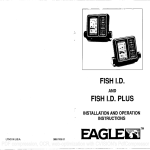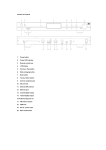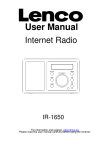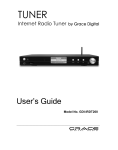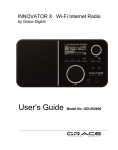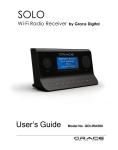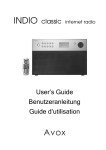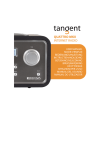Download Mani Palmyra MIR 1017 User manual
Transcript
OWNER’S
MANUAL
Palmyra
Portable Internet Radio
BACK
SELECT
REPLY
D IA L / VO LU M E
MIR-1017
Please read this user manual carefully before using the receiver.
LOCATION OF CONTROLS
1
BACK
5
6 78
2
SELECT
9
3
REPLY
10 11
4
1. Back
2. Select
3. Reply
4. LCD Display
5. Speaker
6. Earphone Socket
7. USB Host Port
8. Play/Pause/Stop
9. Previous
10. Next
11.Preset keys (I/II/III)
12. Power/Dial/Volume
13. DC Socket
14. Wired Ethernet connector
D IA L / VO L U M E
12
DC 9V
LINK
ACT
14
13
Key Functions:
BACK:
Press to go back to the previous display.
SELECT: Press to select a displayed option. REPLY:
Reserved for future services.
I , II , III: Use to store and play up to the radios.
:
Press to pause or playback and hold to stop playback.
:
Press to start playback at the previous track.
:
Press to start playback at the next track.
Dial/volume: Use to search for stations, use to change the option shown
on the display, Use to adjust the volume.
Power:
Press to switch the internet radio Stand By on/off.
-1-
SETTING UP
Step 1- Switching on the radio;
Plug the cable from the AC adaptor into the socket labeled 9V DC on the back of the
radio, then switch on at the mains.
Caution: Use only the mains adaptor supplied with the radio. Connecting a power
supply with a different rating will cause permanent damage to the radio and may be
hazardous.
The display on the front of the radio will light up and say:
Reciva Radio
ARM Powered
after a few seconds, this will change to show:
Connecting to
Network
Step 2 Connect to the network;
Note: At first, you need to select network;
(1)Press the SELECT button;
(2) Turn the dial until the display says “Configure”;
Configure
(3) Press the SELECT button;
(4)Turn the dial until the display says “Network Config”;
Network Config
(5)Press the SELECT button;
(6)Turn the dial until the display says “Wired/Wireless”;
Wired/Wireless
-2-
(7)Press the SELECT button;
(8) Turn the dial until your appropriate equipment;
Auto
Wired Only
Wireless Only
If you select Auto, it will be select automatically.
If you select Wired Only, It will be only used for Wired Ethernet.
If you select Wireless Only, It will be only used for Wireless Wi-Fi connection.
(9) When the ESSID for the access point you want to connect to be displayed on the
screen, press the SELECT button. You might need to enter the correct WEP (Wired
quivalent Privacy) or WPA(Wi-Fi Protected Access) code .
If your network is not configured to need a WEP or a WPA code, the display will show:
Network OK
If the screen displays:
Encryption Key Required
Then the network is using one of the encryption systems:
Wired Equivalent Privacy (WEP) or Wi-Fi protected Access (WPA). You therefore
need to enter the correct WEP or WPA code into the radio for it to communicate with
your network.
After 3seconds the display goes into the code entry mode or press SELECT.
To enter the code, use the dial to select each character of the code in turn, pressing the
SELECT button after each character.
Make sure the character you want is shown in the centre of the display to be able to
select it.
WEP and WPA codes are case sensitive to upper and lower case characters so you
must enter them exactly.
After the final character, use the dial to select END and press the SELECT key.
<{ }~
END
-3-
< >0
The display shows “Connecting to network” as the radio connects to the network:
Connecting to
Network
Then it will be displayed:
Network OK
You my see a message saying <Station Update From Reciva>. This indicates that
some new radio stations may be available since you last connected, or others may
ave ceased to broadcast. The list of available stations will change.
USING THE PRODUCT
Listening to your Internet Radio
1. With “Station” the highlighted menu, press the SELECT button.
Stations
Or if the screen does not display “stations”, turn the dial until it does and then press the
SELECT button.
Genre
2. Turn the dial to choose from <Location>or <Genre>.
<Location>enables you to choose a station from a particular country.
<Genre> enables you to choose radio stations according to their content, for example
90s, Classical, Dance or Rock.
<
Location
>
Or
<
Genre
-4-
>
3. Press the SELECT button to choose the option you want:
st
The display will show the number of stations that are loading. The 1 station name will
be displayed stations are listed alphanumerically.
4. Press SELECT key for the stations you would like to listen.
The display will show <Station Selected Buffering x%> while the station are buffering.
When you are listening to a particular station, the following information will show on
the display:
For example:
BBC Radio 1:Station Name
32 kbps WMA: Transmission Information
Real Enabled: Media player capabilities
Changing the volume:
You can change the volume by turning the dial clockwise to increase the volume and
anticlockwise to decrease the volume. The display shows the volume bar. You cannot
change the volume when you are in a menu or when the radio is connecting to a station.
Storing a radio station in a preset by the panel control:
When a radio station is playing, just hold down one of the preset buttons to store the
station.
E.g. to store preset1: press and hold the preset I.
Assigned to
Preset 1
Playing a preset radio station when a radio station is playing, briefly press the PRESET
button (I,II,III) for the station you want.
Storing a radio station in a preset by the front remote control:
To store a preset, you must first be listening to the station that you would like to save,
then press STORE button. Then press the preset number you would like to save and
allow 2 seconds to store the station into the preset. The LCD will then show <Assigned
to preset #>.
Once you have saved a station to one of the presets, you can recall it by pressing
RECALL button. Then press the preset number you would like to recall and the radio
will connect to your station that you recalled.
Setting the CLOCK
1. Press the SELECT button.
2. Turn the dial until the display says <Configure>.
-5-
<
>
Configure
3. Press the SELECT button.
4. Turn the dial until the display says <Clock>.
<
Clock
>
5. Press the SELECT button.
6. Turn the dial until the display say <Set Time>.
<
Set Time
>
<
Set Time
>
7. Press the SELECT button
00:00
8. Turn the dial until the hour setting is correct, then press the SELECT button.
<
Set Time
>
05:08
9. Turn the dial until the minute setting is correct, then press the SELECT button.
<
Set Time
>
05:12
The display says Time Set with the new time shown beneath for 3 seconds, and then
returns to the radio station display.
Setting the ALARM
1. Press the SELECT button.
2. Turn the dial until the display says<Configure>.
-6-
<
>
Configure
3. Press the SELECT button.
4. Turn the dial until the display says <Clock>.
<
Clock
>
5. Press the SELECT button.
6. Turn the dial until the display say <Set Time>.
<
Set Alarm
>
7. Press the SELECT button.
<
Enable Alarm
>
Yes/ No
8. Turn the dial to swap between Yes/No and press the SELECT button. If you choose
'No' then the alarm is turned off. The display says Alarm is off for 3seconds, then returns
to the radio station display.
Alarm is off
9. If you choose “ Yes” then the alarm is turn off. The display says Alarm is off for 3
seconds, then returns to the radio station.
Set Alarm
07:50
If the radio was streaming when the alarm was set and the unit turned off, the Alarm
will reconnect to the radio to alert the customer when the Alarm expires.
If the media player was streaming music from a PC when the alarm was set and the
unit turned off, the Alarm 'beeps' to alert the customer when the Alarm expires. When
the user silences the alarm the Media player will try to reconnect to the stream it was
last playing.
-7-
10. Turn the dial until the hour setting is correct, then press the SELECT button.
11. Turn the dial until the minute setting is correct, then press the SELECT button.
Set Alarm
08:50
The display says Alarm Set with the time of the alarm shown beneath for 3 seconds,
then returns to the radio station display in standby, the alarm time is displayed in
brackets under the main time.
GETTING STARTED WITH THE MEDIA PLAYER
In order to play the music files you have stored on your PC via the Media player you
must ensure the following:
1. Your PC has the correct type of music files saved on it which are explained in the
following paragraphs.
2. The music files on your PC are not 'protected';
3. Te music files are stored in the correct location on your PC.
4. The PC has file sharing turned on.
5. The music files can be 'shared' on the network.
6. You know the name of your PC.
MUSIC CONTENT
The internet radio plays the most popular music types:
FLIE TYPE
MP3
Windows Media
Real
itunes
Ogg Vorbis
FLIE EXTENSION SHOWN ON PC
.mp3
.wma
.Ra
.acc
.ogg
(These are the letters that appear after the file name. e.g. MUSIC.mp3)
Instructions for streaming
1. Select Media Player on the radio. Switch on the internet radio and press Back until
you are at the top level menu. Turn the dial until Media Player is displayed and press
the SELECT button.
Media Player
2. You will be able to choose from 3 playback tracks;
-8-
Windows Share
Upup Share
Local media
If you select 'Windows Shares' menu:
(1)Scan for PCs is displayed, press the SELECT button. Your computer network will
scan and a list of all available PCs Will be displayed on you internet radio.
Note: If a PC does not have global file sharing turned on, or a third party firewall is
protecting the PC it will not be visible when you scan for it.
(2)Turn the dial to highlight the PC you want to play music from and press the SELECT
button.
Note: you may be asked to enter a username and password to access the PC you have
selected. This is the same user name and password you would enter as sitting in front
of the PC.
(3)Finding folders
The internet radio will now scan the PC you have selected and display a list of any
folder which have got 'sharing' enabled.
Note: Your PC may have folder shared which do not contain the internet radio is just
searching for shared folders, so will find all shared folder, regardless of content. Turn
the dial to select the folder that contains the saved music, and press the SELECT button.
(4)The radio will display 'File Scan…' as it scans through the media files in the shared
folder. Text on the bottom row of the display will change to indicate that the file scan is
in progress. If you have a large number of audio files this could take several minutes to
complete.
(5) Selecting Music
You can now view the content of the shared folder by Album or Artist. Use the dial to
move through the list.
(6)Adding music to the queue and managing the queue. When you select music to be
played, it is added to the play queue and played sequentially.
Note: At the first time the file scan is done, a file called '.reciva_media_cache' is written
to the folder where the audio files are stored. This is in order to speed up subsequent
file scans.
Listening to a single shared track
1.Turn the knob until ' By Artist' is displayed.
2.Press the SELECT button.
3.Turn the knob Until the required artist is displayed.
5.Turn the knob until the required album name is displayed.
-9-
6.Press the SELECT button.' [Add to Queue]' will be displayed.
7.Turn the knob until the required tack is displayed.
8.Press the SELECT button. The track will begin playing.
Listening to a complete shared album
1.Turn the knob until 'By Artist' is displayed.
2.Press the SELECT button.
3.Turn the knob until the required artist is displayed.
4.Press the SELECT button.
5.Turn the knob until the required album name is displayed.
6.Press the SELECT button. '[Add to Queue] 'will be displayed.
7.Press the SELECT button. The album will begin playing.
Queuing up tracks for playback later
1.Highlight the required track.
2.Press the SELECT button. 'Track Added to Queue' will be displayed.
Queuing up albums for playback later.
1.Highlight the required album.
2.Press the SELECT Button.
3.Turn the knob until '[Add To Queue]' is displayed.
4.Press the SELECT button.' Tracks Added to Queue' will be displayed.
Controlling playback
1.Use the STOP button to stop playback.
2.Use the PLAY/PAUSE/STOP button to either pause a currently playing track or to
restart a currently paused track or to restart a stopped track.
3.Use the PLAY/PAUSE/STOP button to stop a currently playing when you press and
hold the button for 2 seconds.
4.Use the PREVIOUS button to start playback of the previous track in the queue.
5.Use the NEXT button to start playback of the next track in the queue.
Browsing the list of tracks currently queued up for playback
1.Press the BROWSE button from the remote control. The currently playing track name
will be displayed.
2.Turn the knob to see which tracks are queued up for playback.
3.If you want to jump to a particular place in the queue the SELECT button when the
required track is displayed.
Playing tracks in random order
1.Select the individual tracks as described previously.
2.Navigate to top-level menu item 'Media Player' using the SELECT and
BACK buttons.
3.Press the SELECT button.
4.Turn the knob until 'Playback Mode' is displayed.
5.Press the SELECT button.
-10-
6.Turn the knob until 'SHUFFLE' is displayed.
7.Press the SELECT button.
8.Turn the knob to select YES/NO the confirm that Shuffle mode should be enabled.
Playing tracks in the queue repeatedly
1.Select the individual tracks as described previously.
2.Navigate to top-level menu item 'Media Player' using the SELECT and
BACK buttons.
3.Press the SELECT button.
4.Turn the knob until 'Playback Mode' is displayed.
5.Press the SELECT button.
6.Turn the knob until 'Repeat' is displayed.
7.Press the SELECT button.
8.Turn the knob to select YES/NO the confirm that Repeat mode should be enabled.
If you select 'UPnP Severs' menu:
Locating and playing media files using the radio and UPnP
1.Once the UPnP server is configure to share media files with the internet radio, you
can play the files by doing the following on the radio.
2.Keep pressing BACK to get to the radio's top-level menu and then turn the knob to
select 'Media Player'.
3.Press SELECT and then turn the knob to highlight 'UPnP Severs'.
4.Press SELECT and the radio will scan for all available UPnP servers. Note, this may
take a few seconds for the radio to complete its scan
and before the scan has completed, the radio will display '[Empty]'. The radio will
continue to display '[Empty] if no UPnP servers are found.
5.After a successful scan , select your UPnP server, by rotating the knob
if there is more than on UPnP server, and then press SELECT.
6.The radio will now list the media categories available from the UPnP server, e.g.
'Music', 'Playlists' etc. Turn the knob to select which category you wish to browse, press
SELECT and turn the knob to highlight a sub category and press SELECT again. For
example, you could select 'Music' and then 'Album'.
7.Turn the knob to highlight the media files that you wish to play and press SELECT.
8.The radio will display '[Add to Queue]', press SELECT and the radio
will add the tracks to its queue and begin playing them automatically.
Setup a Windows PC to allow the radio to access you audio files via
UPnP servers
1.If your PC is running Microsoft Windows XP, then you can use Windows
Media Player 11(WMP11) to act as your UPnP( Universal Plug and
Play) media server 1.0. Windows Media Player 11 may be downloaded from Microsoft's
website and install by following the instructions detailed
in its installation wizard.
-11-
2.Once installed, Windows Media Player 11 will create a library from all
the media files available to it on your PC. To add new media files to the library, select
‘ File > Add to Library…> Advanced Options', Click 'Add'
and choose the files you wish to add and click' OK'.
3.You will now need to connect your Internet radio to Windows Media
Player 11 and configure it to allow the radio to access your media library.
In order to this , you will need to do the following:
a.Keep pressing BACK to get to the radio's top-level menu and then turn the rotary
knob to select 'Media Player'.
b.Press SELECT and then turn the knob to highlight 'UPnP Serves'. c.Press SELECT
and the radio will scan for all available UPnP servers. Note, this may take a few seconds
for the radio to complete its scan
and before the scan has completed, the radio will display '[Empty]'. The radio will
continue to display '[Empty]' if no UPnP servers and found. d.After a successful scan.
Select your UPnP server, by rotating the knob
if there is more than one UPnP server, and then press SELECT (note, your radio will
display' Access Denied' at this stage)
4.Your PC will now prompt you that a device has attempted to connect to your UPnP
server. In order to allow the radio to have access to the
media files, you will need to click the 'Library' tab from Windows Media Player 11 and
select the 'Media Sharing…' item to open the 'Media Sharing' window.
Selecting 'Media Sharing…' for Windows Media Player11 :
-12-
1.From the 'Media Sharing' windows, the radio will be listed as an unknown device.
Click on the unknown device listed, then click the ‘Allow' button and then click 'OK'.
Allowing the Radio to Connect:
If you select 'Local Media' menu:
Press the SELECT to search the Local disk;
You can now view the content of the folder by Album or Artist
Use the dial to move through the list. Adding music to the queue and managing the
queue.
When you select music to be played, it is added to the queue play and played
sequentially,
Note:
If no device on the USB port, when you press the SELECT to search the Local disk, it
will be displayed:
No media
Devices Found
-13-
Configure Menu
Choosing the option you want from the Configure Menu
1.Press the SELECT button.
(Note: If you make a mistake at any point ,press BACK button to go back
to the previous screen.)
2.Turn the knob until 'Configure' is displayed
3.Press the SELECT button.
4.Turn the knob until the display shows the option you want.
5.Press the SELECT button to choose the option shown on the display. The options are
explained below.
<Network Config>
Enables you to configure your radio's network settings, scan again for a connection to
another wireless network, or to manually configure the network parameters. This is
useful if you take the Internet radio to
another building where you want to use.
<Version>
Displays the versions numbers of the various parts of software the hardware on you
Internet radio.
<Upgrade Firmware>
Use this option to download new firmware for the radio from the Reciva portal on the
internet. If there is new firmware available, the radio will prompt you if you want to
download it or not. Note, at this stage, you can press the radio's BACK button to cancel
the radio beginning a firmware upgrade. A firmware upgrade may take several minutes, so
do no switch off the power to the radio until the operation is complete otherwise the radio
may become permanently damaged.
<Language>
Allows you to change the display language.
<Factory Reset>
Puts all the setting back to their default as they were when they left the factory. If you
perform a factory reset on your radio you will loss all you presets and your wireless
network connection.
<Register>
This will display a key that can be used to register the radio on the Reciva Customer
portal.
<Clock>
Use this option to set the time, to set an alarm and to view the current alarm setting,
see'' Setting the clock'', ''Setting the alarm''.
<Sleep Timer>
Selecting this option will enable the Internet radio to switch itself off after a set period.
-14-
1.After selecting the 'Sleep Timer' menu item, the radio will display: 'Sleep Timeout' and
the sleep timer value in the form '00:00:00'(hours:minutes: seconds).
2.Rotate the knob to change to sleep timer value and then press SELECT to begin the
sleep timer.
3.The radio will continue to play as normal, but it will go into standby mode after the
sleep timer has expired.
4.To turn the radio back on again, simply press the ON/OFF button.
<Backlight>
Selecting this option will alter the internet radio's backlight values.
1.After select the 'Backlight' menu item, the radio will display its list of
three menu modes: 'Inactive', 'Active' and 'Standby'. These three states are explained
below:
'Inactive' state when there is no user activity for 30 seconds.
'Active' state is when there is user activity.
'Standby' is the state when the radio has been turned off
2.Rotate the knob to highlight the desired menu mode and press SELECT.
3.The radio will now display the current backlight value for the menu mode. You can
alter this value by rotating the knob to increase or decrease it.
<Contrast>
Selecting this option will alter the Display's contrast ratio values.
1. After select the 'Contrast' menu item, the radio will display the current value of LCD
contrast ratio.
2. Turn the knob to increase or decrease it until the optimum display contrast.
3. Press SELECT to save.
TROUBLESHOOTING
1.If you have trouble connecting the radio to your wireless network, these steps
may help to resolve the problem:
Confirm that a Wi-Fi or Ethernet Wired connected PC can access the internet (i.e. can
browse the web) using the same network.
Check that a DHCP server is available, or that you have configured a static IP address
on the radio.
Check that you firewall is not blocking any outgoing ports. As a minimum the radio
needs access to UDP and TCP ports 80,554,1755,5000, and 7070.
Some access points may be set so that only equipment with registered MAC addresses
can connect to them. This is one possible cause of the Internet Radio being unable to
connect to the Wi-Fi network, and the Internet Radio display will show Bad ESSID or
key. To overcome this problem you will need to add the Internet Radio's MAC address
to the list of allowed equipment in your access point. The Internet Radio's MAC address
can be found using the menu item Configure->Network Config ->View Config -> MAC
address. You will need to refer to the guide for you Access Point in order to enter the
Internet Radio as an allowed piece of equipment.
If you have an encrypted network, check that you have entered the
correct key or passphrase into the radio. Remember that text-format keys are case
sensitive.
-15-
If your wireless network name(ESSID) is 'Hidden'(a setting on the
wireless access point), then you can either turn on the name, or you can manually
enter the name into the internet radio and media player, Select Configure, Select
network, Enter ESSID. Confirm if the Network is encrypted, e.g. requires a WEP or
WPA key, then enter the network name.
2.If your radio can connect to the network successfully, but is unable to play
particular stations, it may be due to one of the following reasons:
The station is not broadcasting at this time of the day (remember it may be located in a
different time zone).
The station has too many people trying to attach to the radio station server and the
server capacity is not large enough.
The station has reached the maximum allowed number of simultaneous listeners. The
station is not broadcasting anymore.
The link on the radio is out of date. This is updated automatically every day, so the next
time you turn on the link will be recognized.
The internet connection between the server (often located in a different country) and you
is slow. Some internet service providers may fail to stream in certain geographical areas.
Try using a PC to play back the stream via the broadcaster's web sit. If you can play
back the station with a PC, use the form athttp://www.reciva.com/station/add_station.asp
to notify us so that we can change the station data that is used by the radio.
If you have a laptop, try connecting it if your Internet Radio cannot find the station.
3.When you scan for PCS none can be found, or the PC you are looking for does
not appear in the list:
Global File sharing is not enabled on the PC.
The PC you are looking for is in another part of the network separated by
a router.(This may happen if you have two access points on the same network, and the
Media source is on one Access Point and the internet Radio is on another).
The PC with the Media content may not have the same workgroup as the server
managing the network. The easiest solution is to change the PC workgroup name to
he same as that being supported by the server.
You have not connected to the wireless Access point. On the internet radio , select
'Configure', 'Network Configure', 'Select Network', 'Scan'
and then select your Wireless network. (You may need to enter a security key to access
the network wirelessly).
You have not enabled simple file sharing on Windows 2000. In Windows
200 the simple file sharing can be turned on by going to the Control Pane,
selecting Folder options, view Tab. The safest way for users to enable the service is to
run the 'Set up a home or small office network' wizard from Control Panel, Network
Connections.
You have a firewall set on your PC which is stopping you accessing shared files.
Windows 2K doesn't come with a real firewall so unless you have installed one this
should not be a problem.
You have a third party firewall in your network, which is preventing file sharing.
-16-
If you have a third party firewall (Like Norton, or Zone Alarm) that will have its own
control panel and you will need to consult the manual for your firewall.
If your PC is connected to a managed network, with a server sometimes the PC being
searched for needs to be server Workgroup.
4.You can see the PC you want to play music from, but cannot find any folders
on the PC:
The folder which has your music in it is not shared. You will need to locate the file you
want to share, right click on the folder, and select
'Properties', Then tick share this file.
The folder is not in an accessible place, i.e. it is in, My music, My documents or on the
Desktop. You will need to mode the folder to the root directory.
You have entered the wrong user name or password for the PC account you are trying
to access. Check and re-enter the user name and password, note the password is case
sensitive.
You have a firewall running which is preventing the internet radio from seeing the
shared folder. As a quick check, you can disable firewalls like Norton to see if this
overcomes the problem, if this resolves the issue
then you can either leave the firewall off, or allow file sharing through the fire wall.
Note: If you firewall is required to provide security for your system, it should not be left
off.
Note: Although you can share a CD drive, you cannot stream music directly from the
drive.
5.Whenever I enter my media folder , the internet radio rescans the content of
the folder:
Although the folder with your music in it is shared, it is 'write protected', so the Internet
Radio cannot save a list of the folder's content back onto the PC, as it needs to rescan
each time.
Tick the box that allows the Folder to be modified across the network.
6.Although I can see my music files in the folder, I cannot play them and the
nternet Radio says they are 'Protected':
When you copied the music files to the hard drive you had 'Personal Rights
management' turned on, this protects the files from being played by a third party device
like the Internet Radio, you will need to copy the music files again, but with the
protection turned off.
You are trying to play iTunes files which have been purchased from the iTunes on line
store,these are protected and can only be played on an iPod. Locally created or 'ripped'
files for iPod can be played as they do not carry the extra layer of Media Protection.
7.I can access the PC with my Media, but when I change to the Use Account, I
cannot see the folder , although it is shared when I check my PC:
The Alternative account on the machine may be Private. If when the account was
]created, the 'Make this account Private' option was selected, then the contents of this
account cannot be seen over the network. You will need to move the music to an
accessible account.
-17-
8.I can't share a folder , as the option is not highlighted:
The share folder option will not be available until you have turned simple file sharing on
Run the wizard.
Scan Error:
When the internet radio is scanning the content of the folders on a PC,it is possible that
a scan error may occur if the windows file sharing application times out. This is most
likely to occur if both the PC with the media content and the Internet Radio are
connected wirelessly.
Try re-connecting the PC with the media content into the network via cable. This will
dramatically increase the speed at which the Internet Radio is able to scan the content
of the Media PC.
Playlists:
Some media ripping applications allow 'Playlists' to be created. The Internet Radio is
able to detect and stream these playlists, but they mustbe stored in the folder with the
rest of the Media content and they must have the file extension.m3u. Windows Media
player can create suitable playlist, just select 'create new playlist', drag and drop the
tracks you want into the playlist, then use 'Save as' to ensure the file type is .m3u.
(Existing play lists can be opened and re-saved in this format) When the Internet
Radio detects you have playlists, it will enable a new menu option allowing the playlist
to be selected and added to the queue.
If you re-connect to another PC of folder, which does not have any Playlists in the .m3u.
format, the playlist option will not be presented in the menu.
9.If the Internet Radio keeps re-buffering radio station:
The Internet Radio is streaming the data from the radio station via your broadband
connection, if there is a high error rate on your broadband connection, or the connection
is intermittent, then it will cause the
Internet Radio to pause until the connection is re-established and it has received enough
data to start playing again.
If your Internet Radio keeps stopping, please check the DSL modem to ensure that the
Broadband line is not suffering a high error rate or disconnections. If you are
experiencing these problems, you will need to contact your broadband supplier.
10.What is Buffering?
When playing a stream, the Internet Radio/Media player, downloads a small amount of
the stream before it starts playing. This is used to fill in any gaps in the stream that may
occur if the internet or the wireless network is busy.
The Internet Radio streams music data from the PC while you are listening. If a stream
gets blocked or experiences Internet congestion while transferring it may stop/interfere
with the quality of play. If this happens, check your internet connection speed- it must
be faster than the speed of the streams.
-18-
Software Licence information
This product contains software licensed under version 2 of the GNU public
license and version2.1 of the GNU Lesser Public Software Licence information
This product contains software licensed under version 2 of the GNU public
license and version2.1 of the GNU Lesser Public License. The source code for
this software is available from:
http://www.reciva.com/gpl
This product includes technology owned by Microsoft Corporation and under a
licence from Microsoft Licensing GP. Use or distribution of such technology
outside of this product is prohibited without a license from Microsoft Corporation
and/or Microsoft Licensing, GP as applicable.
Remote controller
1. Power: Press to switch the internet radio ON/OFF.
2. Mute: Press to mute the voice.
3. Reply: Reserved for future services.
4. 0---9: Numeric buttons for Store and Recall functions.
5. Store: Use to store 100 (0-99) radio stations.
6. Recall: Use to Play up the pre-setting stations.
7. --/-: Select the numeric bits>
8. Select: Press to select a displayed option>
9. Back: Press to go back to the previous display.
10. + VOL -: Use to adjust the volume.
11. UP \DOWN: Use to search for stations, and use to change the option show
on the display.
12. Browse: Press to view the name of the track currently playing and then turn
the dial to see the list of tracks waiting in the play queue.
13. Play/Pause: Press to play/pause playback.
14. Stop: Press to stop playback, with a track name displayed, press and hold to
delete the track.
15. PREW: Press to start playback at the previous track.
16. NEXT: Press to start playback at the next track.
17. MODE:Press to switch Repeat ON/OFF and Shuffle ON/OFF mode.
-19-
www.maninational.com
Mani National Corporation
12 Smoothwater Terrace, Markham, ON, L6B 0E5, CANADA.
Telephone: 416.570.1990
Fax: 905.472.0051 email: [email protected]























